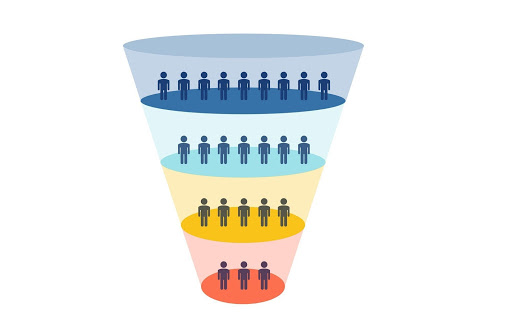Subscribe to stay on top of our latest content!
Share this article
In any business setting, lingo, buzzwords and informal terminology are used as a way of speaking about complex and technical processes and concepts without having to go into extensive detail. Although applicable to a variety of industries, pipelines and funnels are specific concepts that are often connected to the sales industry, and for anyone that is unfamiliar with the alternative meanings, it can be confusing to hear the terms in relation to sales and marketing.
Research has shown that 68 per cent of companies have admitted to not measuring the performance of their sales funnel, and the same study states that 79 per cent of leads for these companies failed to convert into sales. As such, it could be beneficial for companies to understand the meaning of these terms, why they’re important and how they’re unique from one another.

Written by Lauren Shaw
Marketing Manager
Published: 09/04/2021
What is a sales funnel?
A sales funnel is a concept in marketing that identifies the journey that all potential customers go through in the process of making a purchase.
It is compared to a funnel as the process has a similar strategy. With a funnel, there is a wide opening at the top and a small nozzle at the bottom, allowing for a large amount of a substance to enter at the top but only a small amount to exit at the bottom. Likewise, with a sales funnel, a large number of people may enter and interact with your business to start with, but only some of these people are likely to go on to make a purchase.
However, a significant difference between these two types of funnels is that a substance passing through a normal funnel would eventually come out the bottom, whereas with a sales funnel, customers that don’t make a purchase don’t come out the other side if they are deterred by a number of potential factors earlier in the process.
In simple terms, the stages in a sales funnel are:
- Awareness – the largest part of the funnel, all potential customers will be made aware of your products or services. If they catch their attention, they will move on to the next stage. If they don’t, this is where potential customers will leave the funnel.
- Interest – after the awareness of the product or service is shown to the potential customers, a portion of the customers will see if it could be useful to them and will remain interested. They may even seek further information via your social media, website or by subscribing to your mailing list. Anyone that became interested in the product but found it to be irrelevant to them will leave at this stage.
- Decision – following preliminary interest in the product or service, potential customers will decide whether or not to invest in it. More effort will be made to learn about the product or service as well as any selection of packages, offers or discounts there may be. If potential customers have lost interest or don’t see the packages, offers, discounts or general pricing to be worthwhile, they may leave the funnel.
- Action – although the decision stage could be an indication that a potential customer is interested in making a purchase, not everyone follows through with an order. This is the final stage where all customers will be decided – some remaining people will indeed make a purchase based on the information and service they have received, while other potential customers will opt to not make a purchase.

Why is a sales funnel important?
The concept of a sales funnel is applicable to any business, and by understanding how their sales funnel operates, they can begin to understand what keeps potential customers interested enough to make a purchase and prevents others from making it through to the action stage.
By looking at every stage, a business can see what works and what doesn’t before implementing effective changes and potentially improving the ratio of people who entered the sales funnel to people who go on to make a purchase.
What is a sales pipeline?
A sales pipeline is a similar concept to a sales funnel, but instead of looking at the factors that whittle down the number of people that go on to become customers, it outlines the sales process from start to finish.
It’s easier to differentiate the two by imagining the sales funnel as a funnel and the sales pipeline as a horizontal pipe. While the funnel highlights the stages that either encourage a customer to buy or deter potential customers from making a purchase, the pipeline is a predetermined sequence that is more likely to be the same in any similar setting.
Another similarity between the two is that they both have set stages that can be determined, analysed and altered by a business to benefit their effectiveness.
The stages in a sales pipeline are:
- Qualification – sales representatives gather potential leads, analyse them and decide whether they’re likely to be interested, attainable and worth the time and money it could take to target them.
- Communicate – once leads are chosen, communication with them can be planned. In a business setting, this would be a phone call or meeting. If, however, this was a sales process between a company and potential customers, communication could occur in a number of ways such as via social media or email.
- Propose – although the second stage is an opportunity for the sales representative to discuss the product or service with the customer, stage three is an opportunity for the company to send all relevant information to the customer, catch up with them and remind them of their previous communication.
- Close – in the final stage of the pipeline, the sales representative would look to complete the sale with the customer.
Why is a sales pipeline important?
As with a sales funnel, a sales pipeline is something that will apply to any sales process. Likewise, by assessing the existing pipeline, businesses can find ways to remove any areas that could be unnecessarily wasting time or money and implement changes that could improve its effectiveness and success rate.
A sales pipeline is often consistent throughout a business, so it could also be used to compare the output of each sales representative. For example, if one member of the sales team is making significantly fewer sales than another despite using the same sales pipeline, it could be a sign that they’re not as effective as other members of the sales team.
Do I need both a sales pipeline and sales funnel?
As previously mentioned, analysing a sales pipeline will help to ensure the effectiveness of the sales process just as doing the same for a sales funnel will have a similar effect on the factors that encourage consumers to make a purchase.
Even if they’re unaware of these two concepts, any business that deals with consumers or other companies will use some form of sales pipeline and funnel. However, by monitoring these processes, keeping tabs on performance and altering areas accordingly, a business may be able to reduce the number of customers that are deterred by poor marketing, increase sales, improve the performance of their sales team and enhance the impact of their sales process.
Written by Lauren Shaw, Marketing Manager at FLG.
Find out how FLG can help your business
Schedule a demo and let us show you around the platform
Request a demo